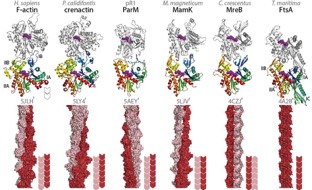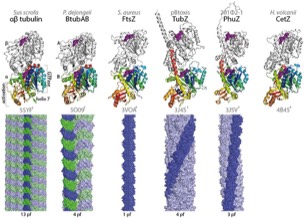Welcome to the group "The Bacterial Cytoskeleton and other Molecular Machines" at the Laboratory of Molecular Biology of the Medical Research Council, UK. We investigate the structure and function of filamentous proteins in bacteria that participate in phenomena such as cell division, chromosome segregation, cell wall synthesis and intracellular motility. We also decipher the mechanisms of other molecular machines, including but not restricted to SMC complexes such as cohesin and condensin.
It was thought that homologues of actin and tubulin (forming F-actin and microtubules in eukaryotes, respectively) are missing from all bacteria and archaea.
Until the mid 1990s it was thought that bacteria lack a cytoskeleton
In the past, we could show that FtsZ and MreB, present in a large number of bacteria, are clear homologues of eukaryotic tubulin and actin, respectively. This is supported by a similar three-dimensional structure of the monomer subunits, similar protofilaments and similar properties that link (de-) polymerisation to nucleotide hydrolysis.
In fact, the nucleotide-driven dynamics of these polymers make them immensely useful for the majority of living organisms since polymer growth and disassembly may be used by cells to generate force. Indeed, they can often be regarded as one-dimensional motors, hence we termed them cytomotive. For further reading we suggest our review in Nat Rev Microbiology (2017).
In addition to our work on cytomotive filaments, we work on bacterial cell division, the process that makes two cells out of one and is the basis for proliferation. In many bacteria the process is organised by FtsZ and we have just started to make progress with our three-pronged approach, which involves cryo-EM on reconstituted complexes, cryo-ET of cells and in vitro reconstitution experiments where we try to make cell division work in liposomes.
A third major focus of the group are SMC proteins and as part of that we are deciphering the mechanisms of eukaryotic cohesin in a collaboration with Kim Nasmyth in Oxford.
We very much enjoy working at the MRC Laboratory of Molecular Biology and we would like to encourage you to read about this amazing place on our institute's websites.
Feel free to get in touch if you are interested in work opportunities here, we regularly have summer students stay for 3-6 months and PhD application deadlines are usually in December. Postdoc applications are welcome at any time.
Jan Löwe
In fact, the nucleotide-driven dynamics of these polymers make them immensely useful for the majority of living organisms since polymer growth and disassembly may be used by cells to generate force. Indeed, they can often be regarded as one-dimensional motors, hence we termed them cytomotive. For further reading we suggest our review in Nat Rev Microbiology (2017).
In addition to our work on cytomotive filaments, we work on bacterial cell division, the process that makes two cells out of one and is the basis for proliferation. In many bacteria the process is organised by FtsZ and we have just started to make progress with our three-pronged approach, which involves cryo-EM on reconstituted complexes, cryo-ET of cells and in vitro reconstitution experiments where we try to make cell division work in liposomes.
A third major focus of the group are SMC proteins and as part of that we are deciphering the mechanisms of eukaryotic cohesin in a collaboration with Kim Nasmyth in Oxford.
We very much enjoy working at the MRC Laboratory of Molecular Biology and we would like to encourage you to read about this amazing place on our institute's websites.
Feel free to get in touch if you are interested in work opportunities here, we regularly have summer students stay for 3-6 months and PhD application deadlines are usually in December. Postdoc applications are welcome at any time.
Jan Löwe
This page has been accessed
times since 1999.


